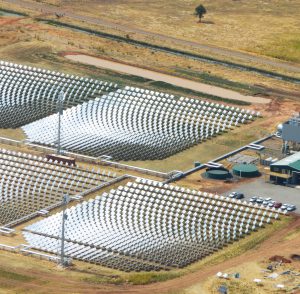The once languishing Aurora Solar Energy Project has taken another important step forward this week after developer 1414 Degrees announced it may add modular concentrated solar power to the project’s current proposed mix of solar PV, battery storage and 1414’s proprietary thermal storage.
Aurora was supposed to be the location of Australia’s first large scale solar thermal and storage project until US project developer SolarReserve failed to get finance and ultimately went broke. South Australia’s 1414 then bought the rights to the undeveloped project and has now signed a Memorandum of Understanding (MoU) with Australian concentrated solar power (CSP) technology company Vast Solar.

The MoU serves to formalise the two companies’ plans to investigate the commercial feasibility of incorporating Vast Solar’s modular CSP technology into the Aurora Solar Energy Project.
Aurora Solar Energy Project is now envisioned as a multi-stage renewable energy park which will start with a 70MW solar PV farm and battery energy storage. The second phase will add 1414’s large-scale, long-duration Thermal Energy Storage System (TESS) which is intended to provide over 1GWh of grid-scale storage.
The project has also included a vague third phase which would turn the project into a “hybrid power station” and include “other technologies such as CSP.” This third phase of the project appears to be the focus of this month’s MoU signed between 1414 Degrees and Vast Solar.
Vast Solar’s modular CSP technology – which has benefited from financial assistance from the Australian Renewable Energy Agency (ARENA) – bills itself as “unlike chemical batteries” in that it is “scalable not stackable.”
The company’s scalable modular CSP arrays eliminate turbine sizing limitations of central tower pants and can be configured anywhere from 50MW to 500MW and boast anywhere from 4 hours of storage through to 16 hours. Further, with multiple smaller towers and receivers, there is no longer a single point of failure.
The newly signed MoU will further Aurora’s goal of becoming “a globally important showcase of world-leading technologies to deliver dispatchable renewable electricity” while providing secure and reliable renewable electricity at low cost.
Low costs and increased revenue is the priority for 1414, and in July a report showed that adding battery storage to the 70MW solar plant would triple annual revenue – with revenues ranging from $44-$80 million, compared to $12.5-$28 million without batteries.
“Although based on historical data that may or may not be a guide to future conditions, these revenue simulations are very encouraging for the development of our Aurora Project,” said 1414 Degrees executive chairman Dr Kevin Moriarty.
“We are working to lock in PPA’s to secure cash flows for the first stage of PV generation to complement the BESS revenue streams.”
The collaboration between 1414 and Vast will first assess the mutual benefits of increased utilisation of the transmission assets, reduction of potential spilled energy, and maximisation of revenue stacks to demonstrate competitive levelised cost of energy (LCoE) and levelised cost of storage (LCoS).